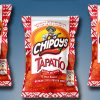The Benefits of PEF for Chips Processing

After sorting, destoning and washing, PEF treatment is one of the first steps in the production process of chips, in both a kettle or a continuous chips line, according to Robin Ostermeier, Claudia Siemer, from Elea Vertriebs und Vermarktungsgesellschaft Gmbh.
The treatment has no influence on the peeling process of potatoes. Also, the peel has no influence on the PEF treatment itself. This allows a constant process with peeled or unpeeled potatoes, which enter the PEF system and are continuously transported by a belt through an electric field. The processing time from inlet to outlet is less than 10 seconds, while the treatment time itself is only microseconds. The size or amount of the raw material can vary, but the treatment remains constant.
Through the application of PEF, the texture of the potato is softer, which leads to an improved slicing, Elea representatives say. A smoother cut brings several important benefits, such as less starch leakage during washing, less breakage and debris as well as longer knife durability. This further results in less particles entering the fryer, which will keep the frying oil quality higher for longer. The PEF treatment can create radical new shapes and cuts for potato chips, or allow for processing of new hard to cut raw material like cassava, sweet potato or taro. Raw materials now have the strength and flexibility to maintain its structural integrity and provide exciting opportunities for novel product development.
The reduction in starch loss during slicing and washing increases the yield of the production line significantly. Therefore, with the same amount of raw material, more chips can be produced. This often pays off the initial investment into the PEF technology alone within short time.
Due to the pore formation in the cell membrane achieved by the PEF treatment, the water diffusion through the tissue is increased. Soluble sugars are washed out, improving washing management for continuously processed chips, resulting in fewer brown and more colorful end products. The increased water diffusion also positively impacts the frying process, which can be optimized with regard to a lower oil temperature and faster frying times. This optimization brings additional benefits to the final chip quality and the process. An improvement of the chip color has a significant impact on optical sorting rejects and the overall yield.
Another point at which improvements can be achieved by the application of PEF is the fat content of the end product. As consumers strive for healthier snack products, reduced-fat products, including chips, are becoming increasingly important. This is also an additional benefit for the chip’s manufacturer, as oil is more expensive than potatoes in most countries. By reducing the oil content, more potatoes are sold, which helps to reduce production costs. This reduction in oil absorption is mainly achieved by changing the raw material due to PEF. As the PEF treatment results in a more flexible product, the surface area after cutting is reduced and less fines as well as breakage are observed. This allows less oil to adhere to the chip surface. In addition, due to the increased water diffusion rate during deep-frying, a protective vapor layer forms around the chip, which prevents the oil from penetrating the product. Overall, the oil content in the end product can be reduced by about 15% (e.g. 33% down to 28%) using PEF. This steam layer also prevents the slices from sticking together (doubles), which tend to have a higher moisture content and would be sorted out by optical sorting.
You can read the rest of this article by accessing your complimentary edition of the Potato Business Dossier by clicking here.

















